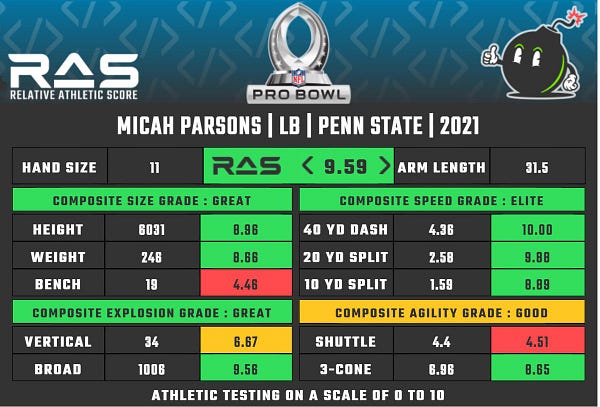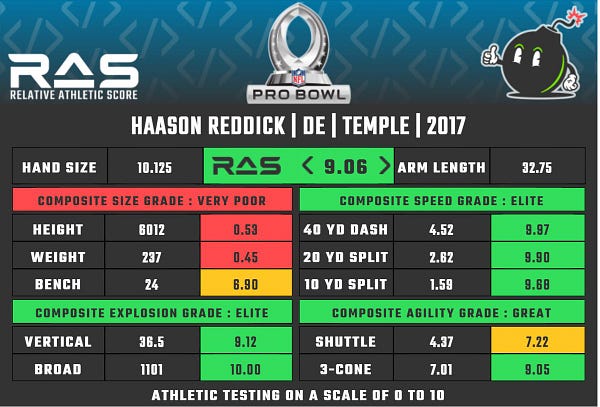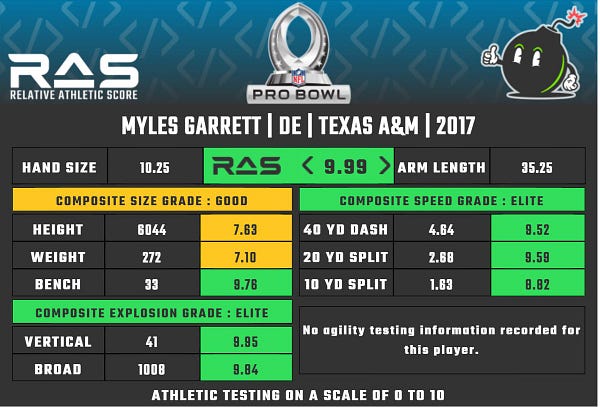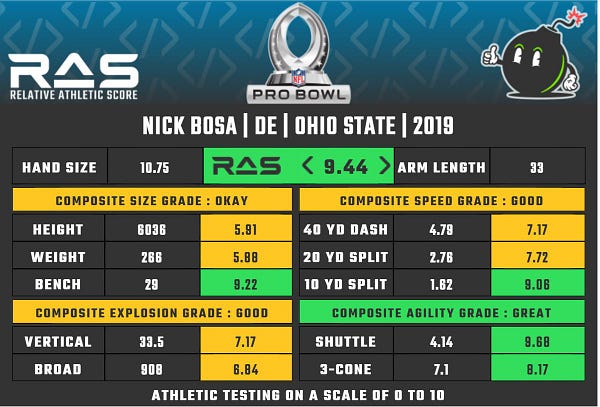What is RAS Score? Why am I using it?
The most important number of the whole draft process? (except for Bryce Young's weight and height lol)
I have added all notable Combine measurements and numbers to every player. Also I have updated my positional rankings. Go check those out!
Note: One of the combine measurements listed is RAS score. If you want to learn about the importance of RAS score and “what is it?” make sure to read this!
The NFL Combine is probably the most important event for players leading up to the NFL Draft. All 32 teams have GMs, scouts, owners, coaches, and more watching, analyzing, and discussing the 300+ prospects that are being displayed in front of them.
The Combine has an on-field drills portion, where wide receivers are asked to run routes with no one guarding them, offensive linemen push weighted sleds, defensive linemen hit dummies that aren’t moving, quarterbacks don’t face any defenses or pass rushers when throwing, tight ends just run around and hit things or catch the football (which is what TEs do in the NFL anyways), and running backs actually showcase some important footwork/agility abilities.
The on-field workout section isn’t translatable to the NFL at all and is a little bit of a joke. Sure seeing how far QBs can throw and how accurate they are is important, but with no defense, no pass rushers, no pads, and no processing abilities needed, the on-field workouts aren’t a realistic way of showcasing a player’s talent or abilities.
The second portion of the Combine contains athletic testing and measuring players’ dimensions. This portion is where prospects start to gain buzz and fly up draft boards. Athleticism is the most important trait a player could have because athleticism allows people to do things that others can’t.
For instance, at the Combine players run the 40 yard dash. At first, it may seem that the drill is useless because players in the NFL rarely run in a straight line for 40 yards; however, when a player runs a fast 40 yard dash, that doesn’t just mean they are fast. Simply put, players are able to move and process things at a faster rate than others.
Think about it like this, when you start to walk or do any type of movement from rest, your brain sends signals down to your legs to start moving. You don’t think about moving your legs when you walk you just kind of do it. Now if you were to start sprinting, you just expect your legs to start speeding up. However, your speed starts to level out because, for the most part, your brain can’t send signals down to your legs fast enough to keep gaining speed. Therefore, players that are fast tend to have quicker reaction time and faster processing skills than others.
Hopefully, now you understand the underlying importance of the Combine’s athletic portion because it showcases the athletic advantages players posses.
Enter RAS…
RAS (Relative Athlete Score) was created by Kent Lee Platte and is a metric that takes all of a prospect’s NFL Combine measurables: height, weight, arm size, hand size, athletic drill results (40 yard dash, vertical jump, etc..) and boils them down into one number on a scale of 0 (lowest) to 10 (highest). The metric also accounts for positional disparities in Combine testing in order to make sure that positions are judged against each other accordingly.
All in all, RAS is the best way to judge a player’s athleticism in regard to their position and height. An offensive tackle who is 6’6 and runs a 5.10 second 40 yard dash can’t be judged on the same athletic plane as a running back who is 5’8 and runs a 4.35 second 40 yard dash. RAS takes all of this into account and creates a cumulative grade for players in order to put them onto the same athletic plane.
RAS score can also be a solid tool in terms of projecting prospects going into the NFL because it tends to correspond with a player’s level of play in the NFL.
For example, the 4 All-Pro edge rushers this past year:





In addition, the 5 offensive All-Pro offensive linemen this year:
RT- Lane Johnson had a 9.96 RAS score in 2013
RG- Zack Martin had a 9.08 RAS score in 2014
C- Jason Kelce had a 9.50 RAS score in 2011
RG- Joel Bitonio had a 9.72 RAS score in 2014
LT- Trent Williams had a 9.64 RAS score in 2010
Not only do these offensive linemen’s RAS scores prove that RAS is a good tool for projecting player’s level of play into the league but also the longevity players can have as all of these linemen are 30+ years old and are still All-Pro caliber players because they’re great athletes.
However, RAS isn’t always right because predicting prospects is very hard. Tom Brady had a 2.74 RAS score and Jarvis Landry had a 0.27 RAS score, and obviously those two have surpassed their “RAS score expectations” and were great players in the NFL.
All in all, RAS isn’t perfect but when evaluating and analyzing prospects, RAS is a very useful tool that shows the athletic propensity in players, and more times than not, RAS successfully projects a player’s level of play in the NFL.
So when your favorite team makes a crucial draft pick during this draft, you might want to check out that player’s RAS score.
(You can find that score in my breakdown for that player or go to https://ras.football/)



